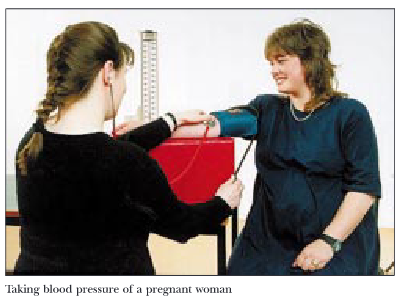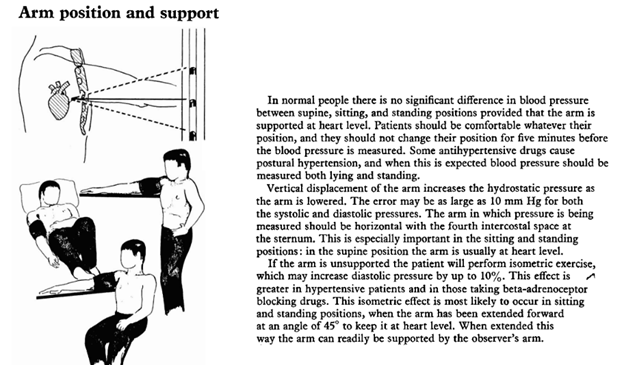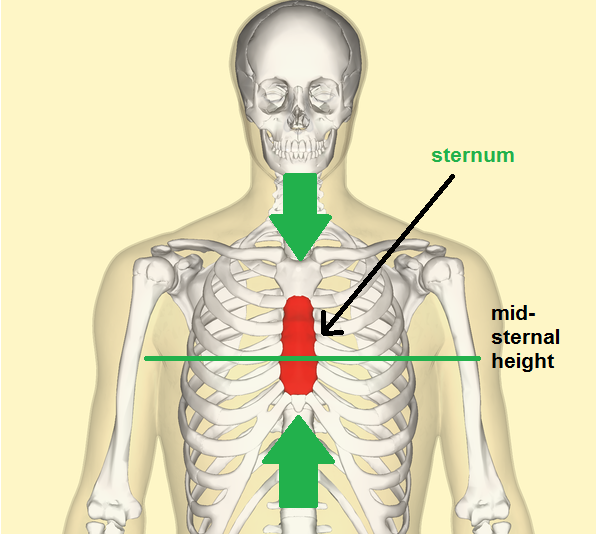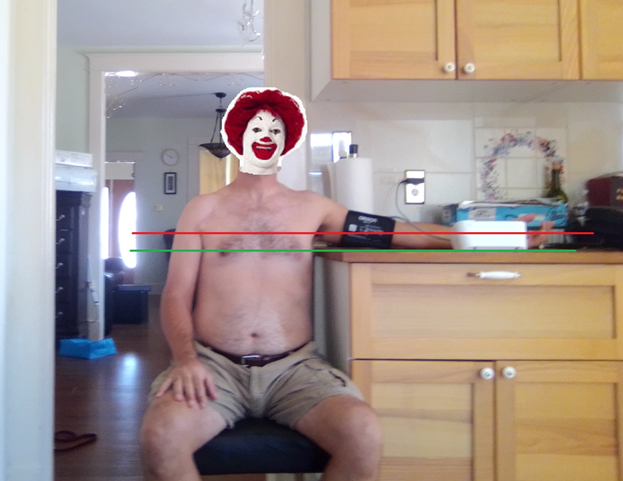The 100% Correct Arm Position for Blood Pressure Measurement Explained
I can’t believe how sloppy blood pressure is being measured these days. They (the “harmaceutical industry”) make a big deal about blood pressure ranges, even down to a narrow, ridiculous 10 point range, telling us that 120 is good, 130 is not, and yet they fail to measure it properly. Chances are, your own doctor doesn’t measure it properly either. Before you call me a smart-ass, let me add that there are many articles online, like this one and other ones written by cardiologists, complaining about that very same thing. So it’s not just me, “insiders” say the same thing. BP isn’t measured properly, it’s an unfortunate fact. Unfortunate for you, but a it’s mistake bringing fortunes to the medical establishment.
What exactly am I talking about? Well there is a long list of things that can go wrong when you measure blood pressure. Click on the previous link to see the list and supporting references. In this post I will deal exclusively with one major “cause” of high blood pressure: your arm’s position.
How I Found Out Something Was Wrong
I bought two upper arm BP monitors, very expensive stuff. And then a few wrist BP monitors. One wrist monitor was really good, I kept it because I liked the numbers it gave me. All BP monitors I bought were “clinically verified to be accurate‘. But why were my wrist monitor numbers lower than the upper arm measurements?
And this is were our doctors fail to see the problem. Doctors will tell you that wrist monitors are inaccurate. That’s simply not true. My wrist monitor now matches the measurements of my expensive upper arm cuff Omron perfectly, even in bed. But a lot of wrist monitors are indeed pure garbage, but so are many regular monitors, too. You must buy a certified device.
It says in the user manual of the wrist monitor, that the monitor itself has to be held right above the heart, on your chest, so that the device is exactly at heart level. I did that and the BP numbers were good. But the numbers coming from the upper arm monitor were higher. Why? So I figured, the AHA must be wrong, I don’t trust them anyways.
The Solution
So I did a lot of research and finally found the answer and fixed the problem. Now my wrist monitor and upper arm monitor closely report the same numbers, sometimes even exactly the same numbers!
To cut the story short, what the AHA (American Heart Association, a corrupt industry construct to funnel money to various dark areas :)) recommends as being the proper arm position, i.e. cuff at heart level but arm bent and placed on a dining table, is incorrect. If you follow the AHA guidelines, or the user manual that came with your Omron, you will likely end up with measurements that are +10-15 points higher, or more, give or take. I.e. what they tell us leads directly to a measurement error!
What does this mean? It simply means, for example, that someone who has 120/80 will measure incorrectly 135/90 and take medicines for a lifetime, unnecessarily. It’s not like blood pressure medications are side-effect free. Some may even cause sudden death, and a range of other problems in the long-term. For Ramipril, for example, they found a 36% higher risk of lung cancer. It’s not “proven cause-and-effect”, it’s only correlation. But you know how these sort of things are enthusiastically researched; who would pay for such research?
Anyways, what is the correct arm position for blood pressure measurement? The correct arm position is the one defined by the WHO (World Health Organization) and also described in full detail by a very popular publication of the British Hypertension Society, called ABC of Hypertension.

Look closely how the arm is positioned. I am not responsible for the pregnancy shown below :):

And here are the details, note the horizontal placement of the arm:

Specifically it states, the arm must be placed horizontally at the height of the 4th intercostal space, i.e. 4th rib, which happens to be the middle point of the sternum, and the height of the right atrium of the heart. I had no idea about anatomy but this is important, so I looked it up so that we finally have an idiot-proof illustration:

See the two green arrows, that’s the top and bottom of your sternum. Measure that from the beginning and end of the sternum, the chest bone. In the middle of that bone, that’s the heart level we want. For most men, that’s roughly where the nipples are. So if you like it when your girlfriend sucks on your nipples, tell her a fun-fact: that’s the “heart level”, baby!
I thought that’s still not enough information. I couldn’t find a satisfying photo online, so I made a photo of my nude body for the entire world to see:

The above picture shows the exact, 100% correct way to place your arm at heart level for blood pressure measurement. I confirmed it with two cardiologists. I researched over 1,000 hours in PubMed. I would bet my house on it :). If you would like to thank me for taking this picture, please support this blog and send me a free T-shirt. And yes, I wear makeup on most days.
What you see above is the following. An overweight person. The green line is the height of the countertop. In my case, in the U.S., it’s 36 inches from the floor. However, all of that doesn’t matter because it all depends on your body size and also the chair height. In my case, it fits perfectly. In your case you might have to place a few books on your dining table or desk to get to the correct height.
I place the arm at the green line. The red line shows the mid sternal height, i.e. heart level, the center of my chest bone. As you can see, the middle of the cuff is exactly at heart level. But this is not the same as the popularized AHA “standard”. They also say you should keep the cuff at heart level, but if you place the arm on a dining table or desk, those are way lower and your arm will not be supported at heart level, it will be far lower. Note, that your height has a lot to do with it. A very short person placing his arm on the dining table will be closer to heart level than a very tall person. His arm would be almost vertical and bent almost 90 degrees.
What happens when your arm is not supported at heart level? If your arm is not supported at all, it’s either vertical or your muscles are tense, or your heart has to pump blood upwards from your arm. In many people, this will increases the BP reading by 20-50 points! I’m not exaggerating; if I measure my BP with the arm vertical, the 90/60 will turn to 120/80. A 140/90 could easily turn into 180/110+! When I measure “AHA” style, my BP numbers are roughly 10 points higher.
Update 2023: Found a new reference European Society of Hypertension recommendations for conventional, ambulatory and home blood pressure measurement. It clearly states: “… The forearm must also be at the level of the heart as denoted by the mid-sternal level. Dependency of the arm below heart level leads to an overestimation of systolic and diastolic pressures and raising the arm above heart level leads to underestimation. The magnitude of this error can be as great as 10 mmHg for systolic and diastolic readings. This source of error becomes especially important for the sitting and standing positions, when the arm is likely to be dependent by the individual’s side. However, it has been demonstrated that, even with a patient in the supine position, an error of 5 mmHg for diastolic pressure may occur if the arm is not supported at heart level”.
What Your Doctor Probably Doesn’t Know Or Care About
I asked a doctor and a cardiac nurse. They told me “that’s how we learned it in school” (literally). Then why don’t you do it? They admitted “no one does it like that”. I guess it’s too much work to do things properly. Also they make more money by measuring your BP wrong. Measuring BP wrong almost always leads to higher numbers, hence to over-prescribing medication. Ergo, it also makes the medication look more effective than it really is at avoiding ‘endpoints’, like strokes and heart attacks.
Imagine the following. Imagine, if making a BP measurement mistake would lead to lower BP numbers, what would happen? They would sell fewer pills. That would cause an instant disaster. The nurses would be sent immediately to 100 courses, to make sure everything is done properly. They would buy devices to make sure your arm is supported properly etc. But it turns out, the mistakes work in the pharma-industry’s favor: fact is, 99% of all BP measurement mistakes result in higher BP numbers.
So what your doctor probably does not know, is that in many people the height of the arm makes a huge difference. But not in everyone. In some people, the difference is small. In some people the difference is gigantic. The same applies to body position. Some people see their BP go down when they lie down. In others, BP goes up considerably. In my case, I might wake up and measure 115/75 in bed, but roughly 90/60 immediately afterward when seated. And, the higher the BP, the higher the effect. If you measure 140 at true heart level, the SBP might go up to 170 or more if the arm is not positioned correctly.
My Recommendations
Arm position is extremely important in at least a large portion of the population. Also in order to get reliable BP measurements, it’s extremely important to follow all rules, such as don’t eat for 30 mins before, keep your feet supported and uncrossed on the floor, back supported, no talking, wait 5 minutes with the cuff on, and check my long list of things that can go wrong when you measure blood pressure. Take your BP at defined times of the day and then also do random measurements, also at night when you wake up. Keep a record of all measurements. Once you have everything recorded, and measured properly and systematically, you will know if you truly have high blood pressure or not. If you measure BP and it’s high, repeat immediately for up to 5 times or until the numbers stabilize. This is another fun-fact that is well-known to a few insiders, which now includes: you!
Otherwise you might end up taking pills you don’t need and that your body doesn’t like. Kidney damage, strokes, and even cancers are among the many possible side-effects. Naturally high blood pressure is also nothing to joke about. However, once you have taken these systematic measurements you are empowered: you can slowly make changes to your lifestyle and see how they impact your BP. I reduced my morning BP from high 130s to low 90s. You can do it, too! How did I do it? Check the links below!
Also Check Out These Blood Pressure “Secrets”
How to Control Blood Pressure Naturally
Best Supplements for High Blood Pressure
The Most Effective Natural Remedy for High Blood Pressure
Take Multiple Blood Pressure Readings for Lower BP
How I Stopped My PVCs, Extrasystoles, Ectopic Heart Beats, Arrhythmia